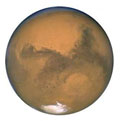Mars did indeed once have seas
 Hamburg - Mars did indeed once have seas, according to a team of German scientists.
Hamburg - Mars did indeed once have seas, according to a team of German scientists.
The dried-out seabeds are etched on the face of the planet in long cracks which intersect - exactly like the parched cracks at the bottom of dried-out lake beds on Earth, say the German researchers.
The scientists investigated networks of cracks within 266 crater impact basins and found polygons reaching up to 250 metres in diameter. The cracked shapes are nothing new. But up until now, the polygonal troughs seen on Mars have been attributed to contractions caused by temperature changes in permafrost.
But a new analysis shows that such thermal contractions could only have created polygons with a maximum diameter of about 65 metres. They cannot explain the existence of large crater-floor polygons.
Ramy El Maarry, from the Max Planck Institute for Solar System Research in Germany, who carried out the study, said: "I got excited when I saw that the crater floor polygons seemed to be too large to be caused by thermal processes. I also saw that they resembled the desiccation cracks that we see on Earth in dried-up lakes.
"These are the same type of patterns you see when mud dries out in your back yard, but the stresses that build up when liquids evaporate can cause deep cracks and polygons on the scale I was seeing in the craters."
El Maarry, a PhD student, identified the polygons from images taken by two spacecraft, Mars Global Surveyor and Mars Reconnaissance Orbiter. The shapes had an average diameter of between 70 and 140 metres. The actual cracks ranged from between one and 10 metres across.
An analytical model developed by El Maarry was used to determine the depth and spacing of cracks caused by stresses from cooling in the Martian soil. Evidence suggests that between 3.8 and 4.6 billion years ago, Mars was covered in significant amounts of water.
Rain and river water would have collected inside impact crater basins, creating small seas or large lakes that may have lasted several thousand years before drying out.
But El Maarry believes some of the crater floor polygons could have been formed much more recently in the planet's northern hemisphere.
"When a meteorite impacts with the martian surface, the heat can melt ice trapped beneath the martian crust and create what we call a hydrothermal system," he said in a news release issued by the Max Planck Institute for Solar System Research.
"Liquid water can fill the crater to form a lake, covered in a thick layer of ice. Even under current climatic conditions, this may take many thousands of years to disappear, finally resulting in the desiccation patterns."
The findings were presented at the European Planetary Science Congress in Germany. dpa